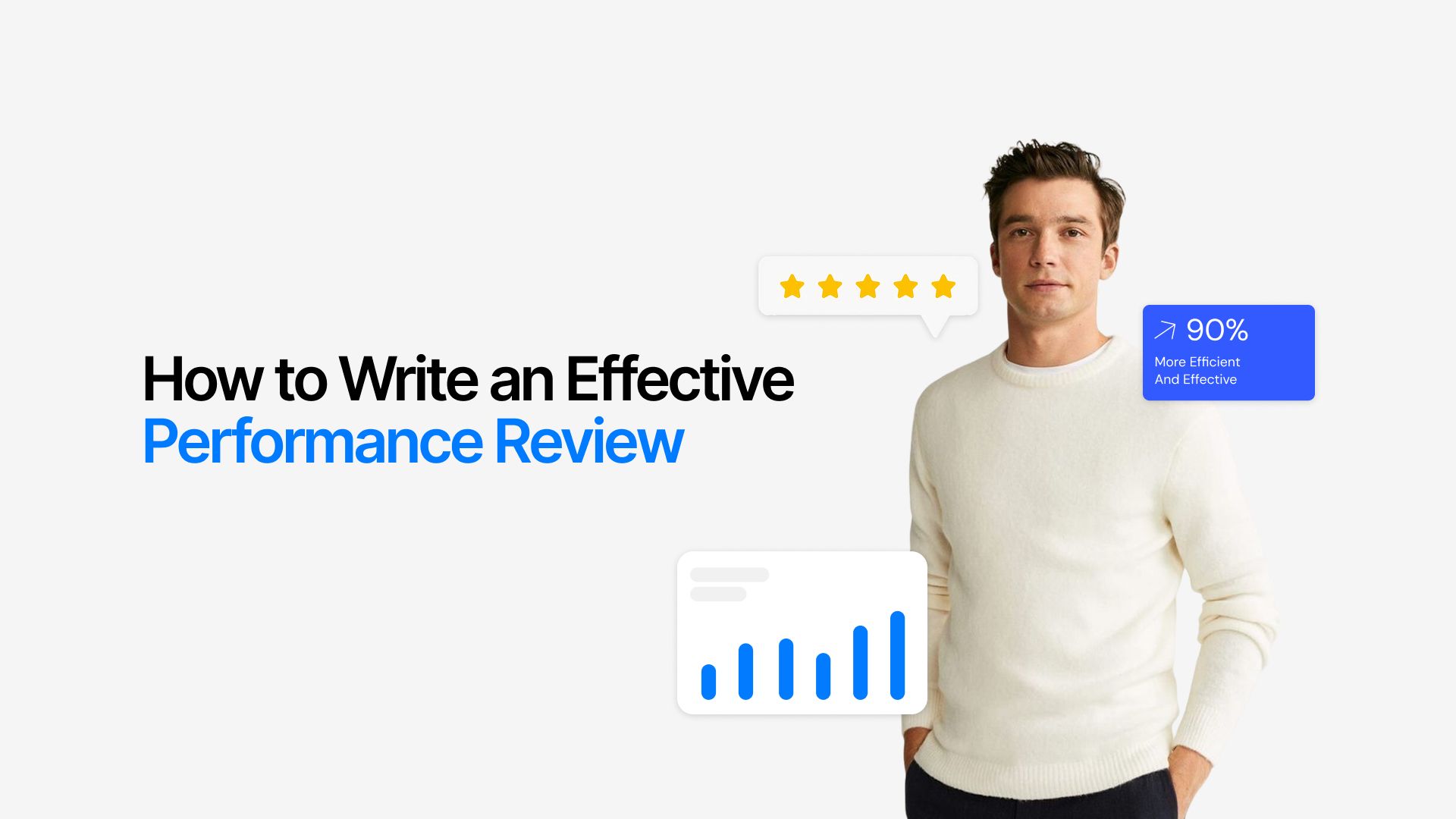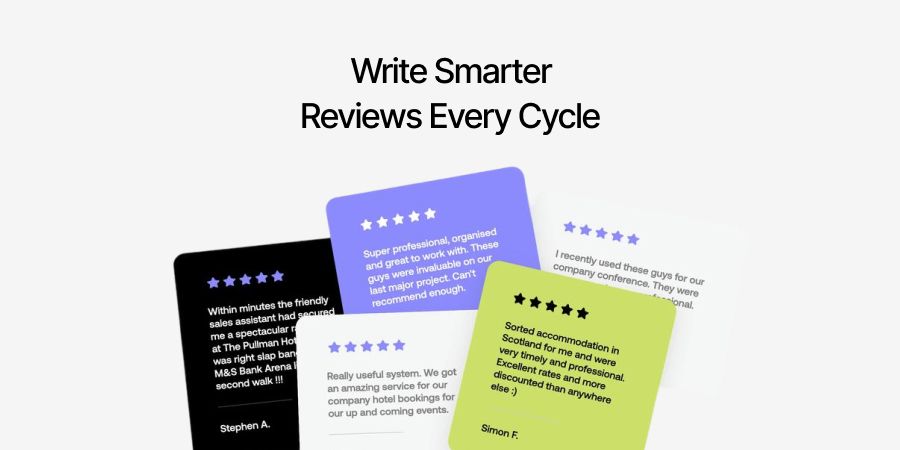
How to Write an Effective Performance Review
An effective performance review balances recognition with constructive feedback. It focuses on facts, aligns with company goals, and gives employees a sense of direction.
Reviews that rely on vague statements or personal bias usually fail to inspire change.
The best reviews contain three elements: acknowledgment of contributions, fair assessment of challenges, and clear guidance for what comes next. With that structure in place, reviews move beyond formalities and become tools for professional growth.
Steps for Writing a Performance Review That Works
Here’s a step by step process following which you can write a killer performance review that is unbiased, focused and useful.
Step 1: Prepare with Data and Measurable Results
Collect performance metrics, project outcomes, and examples of completed work. Relying on memory alone can introduce bias. Data builds credibility and helps the employee see exactly how their efforts are measured.
Step 2: Highlight Achievements First
Begin by acknowledging key accomplishments. Recognizing completed goals, leadership moments, or consistent reliability sets a positive tone. It also makes employees more open to hearing constructive feedback later in the review.
Step 3: Deliver Constructive Criticism Respectfully
Address areas where improvement is needed, but frame feedback around growth. Instead of saying “poor time management,” focus on ways to improve scheduling or workload balancing. Criticism should point to solutions, not just problems.
Step 4: Set Actionable Goals for Growth
Every review should include clear and achievable goals. Goals may include skill development, project targets, or leadership responsibilities. Linking feedback to future steps ensures employees know what success looks like.
Step 5: Invite and Encourage Employee Feedback
Comparison: Writing a Performance Review vs Self Evaluation
Writing a performance review evaluates an employee’s contributions from a manager’s perspective, focusing on measurable results and organizational impact. It is designed to provide structured feedback, recognize achievements, and guide improvement with specific goals.
A self evaluation, on the other hand, allows employees to reflect on their own performance. It highlights personal strengths, acknowledges challenges, and communicates career ambitions. Self evaluations are important because they provide context for how employees perceive their work and future growth.
When combined, both perspectives create a balanced review process. Managers gain insight into employee motivations, while employees receive feedback aligned with company expectations.
Common Mistakes in Performance Reviews
Many reviews fail because they repeat the same errors. These mistakes reduce trust and make employees feel undervalued.
-
Using vague or generic feedback that lacks evidence
-
Focusing only on weaknesses without recognition of strengths
-
Overemphasizing recent events instead of full review periods
-
Ignoring employee input or cutting short discussion
-
Making comparisons between team members instead of individual progress
Correcting these mistakes ensures reviews remain professional, fair, and valuable.
Effective Phrases for Performance Reviews
Choosing the right words is crucial. Phrases should be specific, positive, and actionable.
-
For recognition: “Consistently meets deadlines with reliable and accurate results.”
-
For collaboration: “Plays an important role in team projects and supports colleagues effectively.”
-
For improvement: “Would benefit from developing stronger time management skills to balance multiple priorities.”
-
For leadership: “Shows initiative in guiding peers and contributing to decision making.”
-
For communication: “Clearly conveys ideas and adapts style to match different audiences.”
These phrases keep reviews clear and professional without being overly formal or vague.
How to Structure a Performance Review
A performance review should follow a consistent structure so both manager and employee know what to expect. A simple framework is:
-
Introduction – Set a professional tone, explain the purpose of the review.
-
Achievements – Recognize results, completed projects, and measurable impact.
-
Strengths – Highlight what the employee does well, supported by examples.
-
Areas for Development – Identify gaps without discouragement, linked to growth opportunities.
-
Goals – Agree on specific, time-bound objectives for the next period.
-
Discussion – Encourage employee input and reflections.
This structure ensures balance and clarity.
Tips for Managers Writing Performance Reviews
Good reviews require preparation and fairness. Managers can follow these tips for stronger impact.
-
Collect data from projects, KPIs, and peer feedback before writing.
-
Keep language professional and constructive rather than emotional.
-
Focus on behavior and results, not personal traits.
-
Balance recognition with improvement points for credibility.
-
End with agreed goals and next steps to provide direction.
How to Write a Performance Review Using Chatly
Writing performance reviews often feels like a balancing act between recognition and constructive feedback. Chatly helps simplify this process by turning scattered notes, data, and thoughts into structured, professional reviews.
-
Collect the raw input
Upload or paste bullet points, meeting notes, or key achievements into Chatly. The platform processes the information and prepares a draft that already follows a review format.
-
Highlight achievements and growth areas
With Chatly prompts, you can ask it to split feedback into two parts: strengths and improvement opportunities. This keeps reviews balanced and avoids overly critical or vague wording.
-
Integrate measurable goals
Chatly can convert general statements like needs to improve communication into measurable goals such as participate in at least two cross-team presentations in the next quarter.
-
Ensure clarity and tone
Ask Chatly AI Chat to adjust the tone for professionalism, encouragement, or directness depending on the employee’s role and context. This helps maintain consistency across reviews within the organization.
-
Generate multiple drafts quickly
If you manage large teams, Chatly saves hours by producing draft reviews for each employee based on performance data. You can refine and personalize them instead of starting from scratch.
Using Chatly in performance reviews is less about automation and more about support. It provides structure, ensures language is constructive, and frees managers to focus on meaningful conversations.
Conclusion
Performance reviews are not just formalities. They influence employee motivation, productivity, and retention. A review that highlights achievements, points out clear improvements, and sets practical goals builds trust between managers and staff.
Employees value reviews that are honest yet supportive. Organizations benefit when managers turn reviews into opportunities for growth instead of routine paperwork.
Key reminders:
-
Be specific with feedback.
-
Stay balanced between recognition and constructive points.
-
Set actionable goals to measure progress.
-
Encourage open dialogue to strengthen workplace culture.
A well written review sets the foundation for stronger performance and long term employee engagement.
Suggested Reads
Frequently Asked Questions
Here are the top question that people ask related to writing an effective performance review.
More topics you may like

How to Write a LinkedIn Recommendation in 2025

Muhammad Bin Habib

How to Write a Cover Letter with No Experience Using AI Chat

Muhammad Bin Habib

How to Write a Recommendation Letter for a Coworker

Muhammad Bin Habib

How to Write an Apology Letter That Restores Trust and Respect

Muhammad Bin Habib

How to Become a Freelance Writer in 2025

Muhammad Bin Habib
